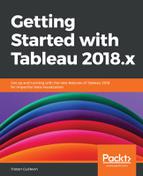Rather than a big list of all the terms, let's go through the basic Tableau usage.
When you open Tableau, you start working on a Workbook. After you're done working, you save your work in that Workbook (a .twb or .twbx file). You can open multiple instances of Tableau, each of them being a different Workbook.
The first page when creating a Workbook is the start page. Here, you can Connect to data and open recent Workbooks. Here is the start page:

After connecting to a File or a Server, Tableau opens the Data Source workplace. On this page, you can create the Data Source by choosing the tables you want to use and creating Joins, Unions, or other transformations. The following screenshot illustrates the Data Source workplace:

Once your Data Source is done, you can start working on a Worksheet. Sheet 1 is your first Worksheet. On the left you can see your Data Source with all the fields, split between four elements: Measures, Dimensions, Sets, and Parameters. Each field has a data type (Text, Number, Boolean, and so on). You can create new fields, such as Groups, Bins, Hierarchies, or Calculated Fields.
The big blank part is the View. It is here that your visualization is displayed. Around the View, you can see different shelves (Rows, Columns, Pages, Filters, and Marks). To create a visualization, you have to put fields on those shelves. Once a field is on a shelf, it is called a pill. Pills can be green if Continuous or blue if Discrete. In your visualization, every distinct element you can select is called a mark. The next screenshot displays the Worksheet workplace:

In Tableau, one Worksheet is one idea, one way of answering a question, and one visualization. You can create as many Worksheets as you want to find the best way to represent your data. Once you have enough Worksheets to answer all your questions, you create a Dashboard. A Dashboard is a combination of multiple Worksheets and objects. You can add actions for interactivity between the different Worksheets and other objects, such as text and image to add context.
If you want to tell a story with your data, you can create a Story. The goal of the Story is to prepare a succession of Story points (each of them could be a Dashboard or a Worksheet). On each Story point, you can add a caption, annotate the visualization, and put some filters that the Story point will remember. So, when presenting or sharing your Story, every interaction or explanation is already done.
You can breathe now! I understand if you think that there are too many words. Don't worry; you don't have to remember all of them now. Each chapter of this book focuses on a specific part of Tableau, and you'll have plenty of time to get familiar with these words with real examples. However, two words need a particular explanation: Dimension and Measure.
